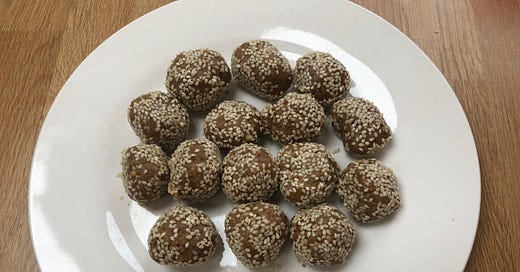Insects: no superfood, just good food
This week in Buzzing:
Insects aren’t the latest superfood, they’re just good food
The Q&A: Kees Aarts, Protix
Test corner: Cricket power balls
Hello everyone, happy World Edible Insect Day! I bet you didn’t know there was one (neither did I until a few days ago 😂 ).
Last year, when I started looking into the use of insects as food and feed seriously, I spoke to Darren Goldin, one of the founders of Entomo Farms, the largest cricket farm in North America. Goldin told me that they’d initially set up Entomo Farms on a sustainability ticket before realising that people were more interested in insects’ health benefits than their sustainability credentials.
That surprised me. The meteoric rise of veganism over the last few years is in great part down to environmental considerations, and I thought that it would be the main driver for edible insects too. But then diet crazes and superfood fads are definitely a thing (remember goji berries?), which made me wonder whether insects would be a flash in the pan.
Insects are high in protein (40-70%); they contain omega-3 fatty acids, high levels of micronutrients, including vitamin B12, which can only be found in animal products, and plenty of fibre too. As Jarrod Goldin (Darren’s brother and co-founder) neatly summed up in an interview: “Not many plants contain B12 and no meats contain fibre.”
This excellent nutritional profile explains why insects are starting to be used as therapeutic foods, basically foods used for emergency feeding of malnourished populations or people with special nutritional requirements. Catholic Relief Services for instance are using it as a supplement for their tuberculosis (TB) patients in southern Madagascar, where food insecurity is high (TB treatments are toxic and require a healthy weight). And World Vision are using insect powders to address malnutrition in Elgeyo Marakwet County, Kenya as part of their maternal and child health programme.
It’s not all about the protein however: insects’ exoskeleton is made of chitin, and this is thought to have important benefits for gut health. Researchers at the University of Wisconsin-Madison ran a small clinical trial in 2018 that showed that eating crickets promoted the growth of beneficial gut bacteria and helped reduce inflammation. Neil Whippey, Eat Grub’s co-founder, wrote a very personal blog about how insects have become essential for managing his Crohn’s disease.
The one thing insects don’t have on their side is allergies: because insects and crustaceans are closely related (crickets are basically sky prawns), people allergic to seafood, and house dust mites to a lesser extent, are likely to be allergic to insects too.
I am fortunate enough not to lack food and be healthy, but as I cut down on meat and dairy, the idea that there is something I can add rather than remove from my diet is exciting. As an individual, I want it to be sustainable and taste good, but as a parent, I am glad insects have so much to contribute to my children’s nutrition.
I think insects as food and feed are here to stay, if only because they were here all along. It’s just us in the west that need to label them novel or super in order to eat them. Thinking of them as food, good food, is what will stand the test of time.
The Q&A: Kees Aarts, founder & CEO of Protix
On a diving trip in Mozambique in 2009, Kees Aarts had an epiphany about the link between overfishing and food production. He decided to explore the idea of farming insects to produce an alternative source of protein and quit his job as a management consultant. A decade on, Protix is now a leading producer of black soldier fly ingredients for animal feed. The flies are fed food residues and the facility is fully-automated, featuring the latest innovations in remote-control systems, robotics, artificial intelligence and genetic improvement. This week, they were awarded the Dutch Innovation Award 2020 for their progressive role in food sustainability.
Arnold van Huis recently mentioned in a webinar that he’d visited your “graveyard”, the facility where you store discarded equipment: how much has your technology evolved in 10 years?
We have a formula at Protix: innovation is the outcome of pioneering and pioneering is curiosity and relentless perseverance. The graveyard is proof that we persevered. Our vision was clear, we engineered everything and we failed many times. And every time, we’d have to walk down to the graveyard. But now we have a large-scale facility up and running.
Innovation isn’t a PowerPoint presentation. We had to build the damn thing and show the world that it’s alive, so the timing of [the Dutch Innovation Award 2020] was great. I would not have liked to win it three years ago, because then we would have been nothing more than the rest: a small company with a small production facility promising the future.
What’s next for Protix? How big a deal will it be that insects are allowed in poultry feed in Europe?
We are going to keep innovating and we’re going to step on the gas and build more plants, in Europe, the US, Canada and then Asia.
The authorisation to use insects in poultry feed will be a big deal. Chickens naturally eat insects, so it’s a very logical story. Consumers get it, and they understand that it’s better to feed chickens a locally produced protein than an unsustainable one from abroad [soy]. We have science to back the fact that it is good for the chickens too. Insects are more expensive than soy but consumers are asking for change and developments point to the convergence of cost towards value.
You recently launched Enough [a brand of insect snacks]: why did you take the jump from insects as feed to insects as food?
We want presence in all markets and insects as food is an interesting market to keep an eye on. We like what we see in the reactions of consumers: they are broadening their views about what a sustainable future looks like without preconceptions of what is food. Playing with food is OK but playing with the planet isn’t. That’s a big change from the post-WW2 paradigm. The thinking behind this is very emotional but the “footprintarian” – someone who strives for a modern life with a positive footprint – is open and rational about it.
Test corner: Cricket blissballs
After my dalliance with the cricket burgers last edition, I was determined to make something with crickets I actually liked. And I did: say hello to my cricket power balls, aka blissballs. These power snacks seem to be a popular cricket recipe: I found quite a few versions online and ended up settling for the Eat Grub recipe because I liked the sound of the lime zest.
The blissballs were predictably easy to make, especially for little hands: blitz all ingredients in the food processor, shape into balls, roll in coconut, chill. A bit like playdough for cooks. The main flavour here was the zing of the lime, followed by the coconut, which got mixed reviews. I made a second batch the following week, but this time, I substituted the desiccated coconut for sesame seeds, left the lime out and added a tablespoon of tahini. Bingo. I absolutely loved these, as did everyone else at home. I had to wrestle the food processor bowl from Little-boy-who-eats-everything who suddenly no longer cared about rolling anything and just wanted to eat. The combination of dates, peanut butter, tahini and crickets was totally moreish.
This culinary hit was all the more surprising because I had another cricket flop: cricket pancakes (the kids loved them, but maybe it was the maple syrup?). I’ve worked out that it is the cooking that brings on the liver-like aroma I don’t like in crickets. If any insect food scientists are reading, I would love some explanation about why that is. Until then, I will stick to cold dishes for crickets (smoothies is another recipe suggestion that comes up regularly) and will use mealworms or buffalo worms for cooked food. Let me know how you get on: I recommend the power balls with a cup of coffee 😊
Cricket blissballs:
100g dates
50g almonds
3 tbsp peanut butter
1 tbsp tahini
1 tbsp cricket powder
Sesame seeds for the coating
Blitz all ingredients in the food processor, shape into balls, roll in sesame seeds, chill.
Hi, I’m Emilie Filou, a freelance journalist. I specialise in business and sustainability issues and have a long-standing interest in Africa. If you liked Buzzing, please share with friends and colleagues, or buy me a coffee. My funky cricket avatar was designed by Sheila Lukeni.





